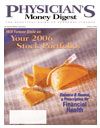Publication
Article
Physician's Money Digest
Will You Retire as Comfortably as You Want?
Author(s):
Most physicians who expectto retire comfortably areheaded for a rude awakening.It's going to take a lot more moneythan you think to retire at the level youhad intended. Not only will livingexpenses cost more than you think, butyour assets probably will not grow asfast as you would like.
Consider these figures. If you currentlyrequire monthly living expenses of$10,000, you will need an additional$5000 each month in 10 years, based ona modest 3% inflation rate every year.Given an after-tax annual return of 3%to 5%, it will take $5 million to $6 millionin liquid assets for most doctors toretire comfortably. This amount excludesnonliquid assets that tend to beincluded when calculating an individual'stotal net worth. Physicians mustalso factor additional health expensesinto their future monthly income.
In addition to underestimating theirmonthly needs, many investors tendto overestimate their future portfolioreturns, and many think their portfoliowill earn annual after-tax investmentreturns of 15% or more, which is unrealistic.As physician-investors near retirement,their portfolio allocations shouldfocus on stability rather than growth.Historically, the annual rate of return forbonds is 5% to 6%, and stocks earn 9%annually before taxes—averages that areunlikely to change much in the future.
Very few portfolios avoid the occasionallosing streak. Although an aggressiveinvestor may make 50% in a yearwhen the stock market only gains 8%,they may lose 50% the next year whentheir speculations crash. Despite thisloss, the investor figures that they brokeeven over the 2-year span, which is notthe outcome they had hoped for, butcertainly not a disaster. Yet what theinvestor does not realize is that the timerequired to make up for a single losingyear is far longer than expected.
In order to reach the comfortableretirement you want, you must form ateam of competent advisors. An investmentadvisor will help construct variousretirement scenarios, determine necessaryannual contributions, and manageassets within your personal risk tolerance.While there is no one right investmentadvisor for everyone, you certainlywant to know that you, your advisor,and the other members of your team areall on the same page. Advisors with largeamounts of money under their managementcan seem like a safe choice, but themore money a manager takes in, theharder it is to deliver performance abovebroad market returns. While typicallynot a physician's first consideration inchoosing an investment advisor, a recordof avoiding large losses may be the mostimportant aspect of an advisor's resume.
Investors must always keep in mindthat without safeguarding their investableasset base, there is no opportunityfor future returns. In most years, it'sbetter to have a 15% return with only30% of your capital at risk rather thanrisking 100% of your capital with a20% return. That's because if a naturaldisaster, act of terrorism, currency devaluation,interest rate or inflation spike, orany other event creates a market tremor,the portfolio with the least capital at riskis best insulated.
Seek out ways to introduce undervaluedassets and additional income intoyour retirement plan. Many physiciansown their practice's building with a lowcost basis, which can be purchased andincorporated into their retirement plan.This strategy shelters the income as wellas the proceeds if the building is sold.Often, debt on various assets can befinanced by a pension plan, which generatestax-free interest that is nonethelessdeductible. If you and your advisoryteam review your assets and come upwith a feasible retirement plan, the futureyou want will be possible.
Steven Holt Abernathy is principal and chairman
of The Abernathy Group in New York, NY.
The organization provides wealth management
and financial services to medical professionals.
It has been ranked the top money
manager in the nation 8 times in the past 12 years by
Nelson's. Mr. Abernathy welcomes questions or comments
at 212-293-3469 or sabernathy@abbygroup.com. For more
information, visit www.abernathyfinancial.com.
